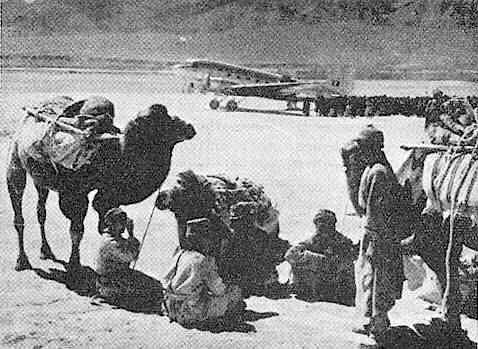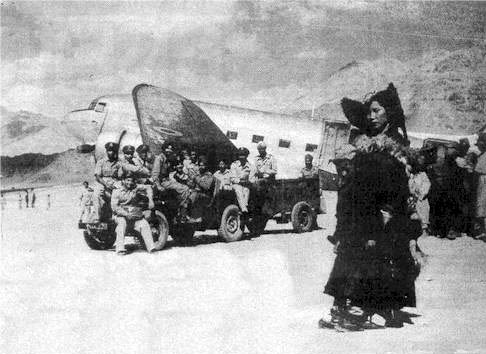It is somewhat ironic that in 1999 we should be fighting to relieve pressure on the very region that had to be secured in 1948. In the following piece from the BHARAT RAKSHAK Monitor recounts the first defense of Leh.
In an attempt to forcibly annex Jammu & Kashmir to Pakistan in 1947, the Pakistani Army and tribal irregulars launched an invasion of the state in October of that year. Looting, pillaging and murdering along the way the tribals’ pace of advance gave the Indian Army precious time, in which to secure the Kashmir Valley and Srinagar. For much of that winter the fighting was restricted to the Valley and the southwestern portions of the state. The Ladakh area to the northeast remained undisturbed by the fighting. The terrain in this area was very difficult and it was relatively remote, not just from the rest of India, but also from the rest of the state. The major city in this region Leh, lies some 360 km east of Srinagar and 400 km north of Manali. Kargil is the major way point along the Srinagar-Leh route. In 1948, Leh was connected to the outside world only by tracks and a solitary telegraph line that ran to Srinagar. The highway was not built until 1955. The only means of transport between Leh and the outside world were yaks, ponies and porters. Until 1948 the residents of Ladakh had not yet seen wheeled transport. Modernity, unfortunately, arrived with a bang following the Pakistani invasion.
Attracted by the treasures of Buddhist monasteries in Leh, the invaders started making plans for the invasion of Ladakh in early 1948. By then they had already occupied most of Baltistan and the Gilgit area, and the small Kashmir State Forces garrison at Skardu came under attack in November 1947. A relief column was dispatched from Leh to help in the ultimately futile defense of Skardu, leaving behind a mere 33 soldiers to guard Leh. In February 1948, the Pakistanis launched “Operation Sledge” with Gilgit as the base. The offensive sought to make a flank attack to capture Skardu, Kargil, Zoji La and ultimately Leh. As Skardu came under siege, people in Leh began to panic. With a mere 33 troops at hand, Leh was virtually defenseless.
Sensing the danger to Leh 161 Infantry Brigade decided to send whatever meager relief it could across the Zoji La. An all volunteer Lahuli column of 40 men led Major Priti Chand, a Lahuli officer of 2 Dogra, set out from the Valley in mid-February. This column knew full well the hazards of crossing the Zoji La at the height of winter, indeed it had never been done in living memory. It was the sheer courage of these men, that saw them reach on 8 March 1948. Their arrival brought relief to the city and by the end of April more arms and ammunition was reached Leh. Priti Chand’s march was greatly helped by the fact Skardu was still and obstacle in the invaders’ path and Kargil was still in Indian hands. But Kargil fell on 10 May 1948 and communications between Leh and Srinagar were cut. On the 22 May the invaders began an assault against the Indian platoon that held the bridge at Khalatse, a day’s march from Leh and the whole situation turned grim.
Priti Chand sent out frantic appeals for airborne reinforcements to Divisional HQ in Srinagar. To facilitate this a Ladakhi engineer constructed an improvised airstrip at Leh. However, the height at which the strip was located and its surrounding topography posed a major challenge to the India Air Force. Serious doubts were expressed about the ability of the IAF’s aged and battered Dakotas to fly into Leh. Even Air Commodore Mehar Singh, DSO, the daredevil Air Officer Commanding No.1 Operational Group in Kashmir was concerned about the Dakota’s efficacy. Major General Thimayya, then commanding the Kashmir area, saw no alternative to reinforcing the Leh by air and set out to convince Mehar Singh.

The first RIAF Dakota to land at Leh. For many of the Ladakhis, they have never seen even a motor vehicle, let alone an aircraft.
Mehar Singh eventually accepted the challenge of flying into Leh and Thimayya opted to be on that first flight. Braving difficult terrain Mehar Singh and Thimayya landed in Leh on 24 May 1948, establishing beyond doubt that the Dakota was capable of opening an air bridge to Leh. In the process they had also set a record by landing at what then became the world’s highest airstrip.
Thimayya set about talking to the troops at Leh and assuring them that reinforcements would start arriving within a day or two. A key obstacle to reinforcing Leh had been overcome. However, for three days after Thimayya’s visit poor weather meant that nothing could be done about reinforcements. And when the weather cleared Thimayya was suffering from problems of his own. There were shortages of booth troops and aircraft as both were heavily committed around Poonch, Tithwal and Urusa. All this forced Prithi Chand to pull back forces from the forward areas and prepare to defend Leh to the last man. A relief flight of 6 Dakotas were sent out on 31 May, but had to return to Srinagar because of bad weather over the mountains. They took off the following morning and made it into Leh safely. This relief flight led by Mehar Singh himself brought in a company of Grouches, who lost no time in going into action. Leh, at least for the moment, was saved.
RIAF Officers pose with the first Jeep to be airlifted to Ladakh in a Dakota.
Towards the end of June the forward areas came under attack from an additional 600 Pakistani regular and irregulars. Despite inflicting stubborn resistance put up by the Gorkhas, a shortage of ammunition and the danger of being outflanked forced them to fall back. By mid-July the situation in Ladakh was desperate. Only 20 regular troops and 150 militia were defending Leh itself, and another 200 militia were in forward positions. The defenders were short of ammunition, weapons, clothing and even medical supplies. By the end of July 1948 only two boxes of mortar ammunition were left in Leh. On the other hand the number of attackers continued to increase. Despite the urgent need to airlift troops and supplies into Leh the weather precluded any such efforts until mid-August. Skardu fell on 14 August 1948 and more Pakistani forces were freed to attack Ladakh.
However, from 15 August onwards the weather improved, reopening the air-bridge into Leh. On 23 August, Lt. Col. Parab (CO 2/8 Gorkhas) and his unit began arriving in Leh. The Dakotas also helped evacuate casualties on their return flight out of Leh. By the end of August more troops began arriving overland along the Manali-Leh axis and supplies of ammunition and equipment were built by at Leh. By the end of October a battery of 4.2 inch mortars was in and the troops at Leh were finally in a position to mount a counter attack. Khalatse was retaken on 23 November 1948. The following day Indian troops advancing across the Zoji La and Parab’s troops met up at Kargil. By the end of November the entire south bank of the Indus had been cleared of the invaders and the Srinagar-Leh land route was firmly in Indian hands, and Leh was secure. During those four months some 700 Dakota sorties contributed to the defense of Leh. With Ladakh secure, the Indian Army planned to launch an offensive against Skardu. However, the Government of India’s decision to accept the UN mandated cease-fire in January 1949 stopped the Indian offensive in its tracks leaving Skardu and its surrounding areas with Pakistan.
